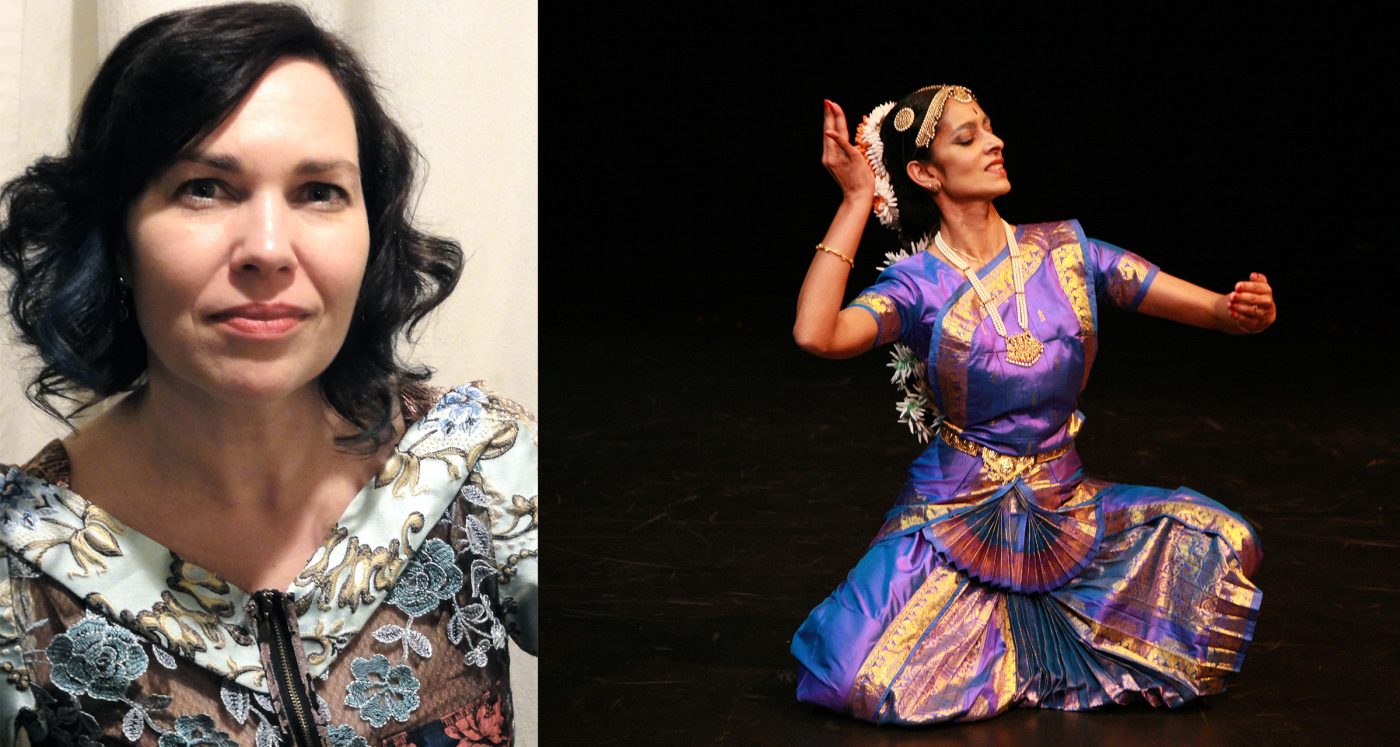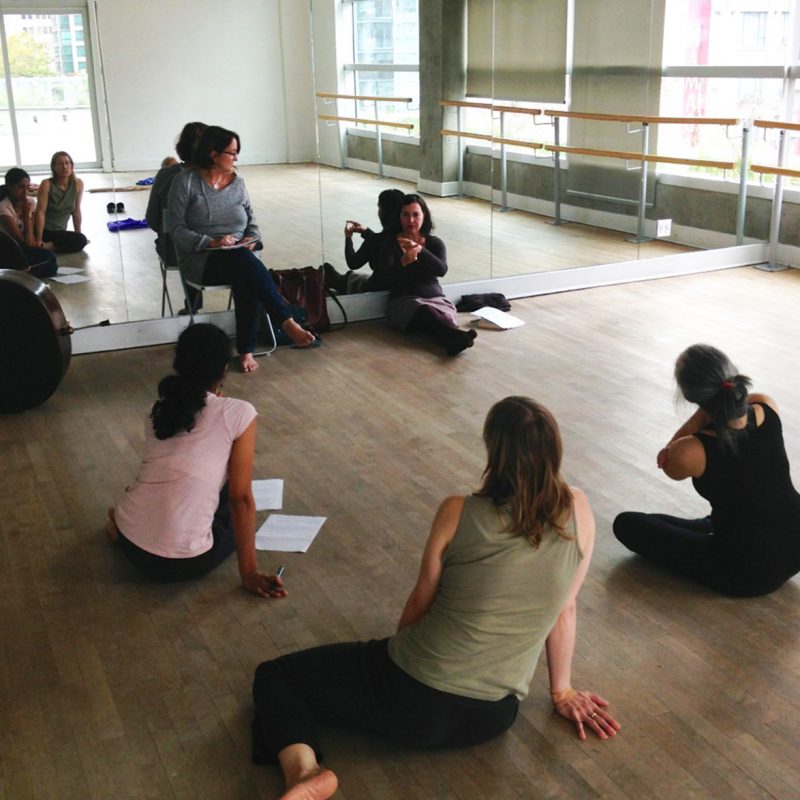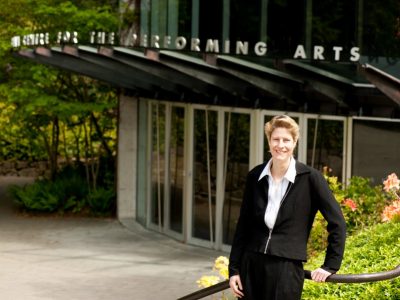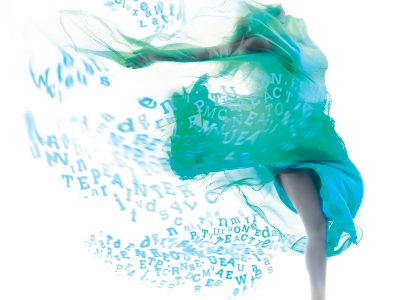- News
- Q & A with Aislinn Hunter and Anusha Fernando
Q & A with Aislinn Hunter and Anusha Fernando

How did you approach the process of integrating ideas, narrative and words into your choreography?
Anusha Fernando: Aislinn’s novel (The World Before Us) is a very rich and nuanced work. It was quite daunting to envision how one would express such a complex novel in 15-20 minutes. I was thrilled when I found a poetic passage that prefaced the main text, which seemed like the perfect piece of writing. It encapsulates many of the themes of the novel and contains many beautiful images that I could immediately envision being physically expressed.
Bharata Natyam is a storytelling form and dance choreography often involves bringing the words of a poet to life. So, it wasn’t unfamiliar territory to be presented with a text as the source for movement ideas. However, the expressive language of Bharata Natyam, which utilizes hand gestures, eyes and facial expression, is meant for certain types of stories. So, the challenge was applying this language to a different type of text, stretching the meaning of the gesture or creating my own expressive gestures beyond the traditional vocabulary. Also, it was fun to play around with making a gesture out of multiple bodies. Aislinn’s language is poetic and contains strong images, so the choreography is imagistic and suggestive just like the text.
The novel’s central story revolves around the disappearance of a young girl and how that event effects many lives but it is also about the flow of experience. It explores the connections between the past, present and future, how things appear and disappear. This attention to the flow really resonated with me. Prior to this project I had been thinking a lot about the flow of breath, how central that is to dance, the importance of inhalation and exhalation for our very lives. So, when I began to consider what other movement forms I may use, I chose forms that have breath as a focal point, that are deeply rooted in the awareness of breath. The text is spoken with multiple voices and so it felt like having more than one mover made sense on that level as well. These voices are similar but distinct, so I chose movement forms that have similar roots to Bharata Natyam. They all have distinct vocabularies but many of the movements and the intentions behind the movements are related.


What has been the most surprising or unexpected part of this collaboration for you?
AF: I was really surprised at how easily and joyfully this project came together and also how working with a different kind of text really fuelled my creativity. There was something about breaking away from familiar words and worldview that shaped the movement possibilities in a completely different way. The possibilities suddenly seemed endless. There is no doubt that I will continue to explore different types of text in my next projects as I am really enjoying the possibility of moving in any way I choose.
It was also incredibly helpful to get feedback from other artists on my work. In the Indian Classical dance world, we are usually critiqued by our teachers, who exist within a fairly small orbit, and the criteria is usually are you doing this perfectly or not? There is not a lot of attention to the personal intention of the dancer. In fact, the personal perspective is not considered to be of much value. To be stimulated with questions of a different kind was very useful in clarifying the work. It was also interesting to have artists involved, such as Martha Carter (Words in Motion project consultant and Artistic Director of Marta Marta Productions) and Aislinn Hunter, who had no preconceived notions about Indian Classical dance and could really be outside and unbiased in their views.
How do you feel the original meaning or ideas behind your words have been altered, changed or enhanced by this new connection to movement?
Aislinn Hunter: Well, to start I’d have to say that the original ideas have definitely been enhanced by Anusha’s choreography and the incorporation of movement into the framework of the book’s themes and queries. I think in some ways The World Before Us is a tricky book to materialize in part because it’s narrated by a chorus of the invisible dead who don’t remember who they were, and who are therefore moving around/circling a British archivist named Jane in the hopes that she will discover their identities and past for them. If parts of the book were being taken literally this might have presented problems, but from the get-go Anusha seemed to have a handle on how to present and reveal all the tensions the book explores: bodies/minds; presence/absence; distance and connection, even sense and nonsense/madness. I think her mastery of the Bharata Natyam discipline probably factors in her ability to embody feelings and emotions or states of being in a way that doesn’t demand a literal representation. I was lucky enough to see her give a traditional performance early in our collaboration and I was blown away: what the flick of a wrist could convey or a sideways glance!
Hilariously (in retrospect), I think I imagined early on that there might be a scene of a dancer running through the woods – something sort of from the ballet world of my childhood: traditional set, dancer running a wide circle (with a few grand jetés thrown in for good measure) arms wide to symbolize being lost (go ahead and laugh – it’s funny), but it became clear that Anusha wasn’t that kind of dancer and that the other ‘movers’ (which is how they refer to themselves) weren’t about to jeté either. Thing is, that wouldn’t have been as right as what Anusha came up with. I think that in the end Anusha (wisely) felt that because the themes of the book were universal less had to be done to represent the literal narrative. So she gives us a fully embodied performance where the score and the movers bodies and poses and stillness are signs and symbols and glyphs. I see parts of the book in different movements in the work (like ‘Ohhhh that’s like the part where ‘X’ happens…’) but I think most audience members will just be caught up in the nuanced feelings Anusha has managed to amplify and explore.
What has been the most rewarding part of this collaboration for you?
AH: The first thing that comes to mind is meeting Anusha. She’s wonderful – and thoughtful and tough, which I like. I am not someone who has done a lot of collaboration so I’m grateful I ended up with someone I enjoy spending time with and whose insights teach me something about the work. When they made a film version of my first novelStay I was left out of the process until filming started and my husband and I were invited to be on set in Ireland. Veda Hille wrote a beautiful song based on The World Before Us and it was simply presented to me at the end. Luckily I thought both the film and song were splendid – which tends to make me want to get out of the way and trust the artist whose engaging with my work. So, the give and take with Anusha, the discussion, was weirdly new. Right away I liked how often she said no to me without rolling her eyes at my ideas, and I liked how genuinely and professionally she took my notes and suggestions as the choreography was developing. I guess too there’s the idea of even been asked to take part in this project.
As a writer one hopes most of all that one’s work will speak to others. To have a chance for the book to speak through the language of dance and movement is to me extraordinarily humbling and exciting. I’m thrilled with what Anusha has done.
Tickets are still available for Words in Motion on March 18 + 19, 2016. Get yours here.


